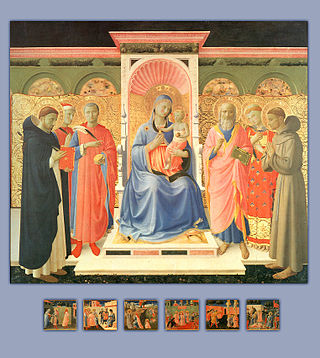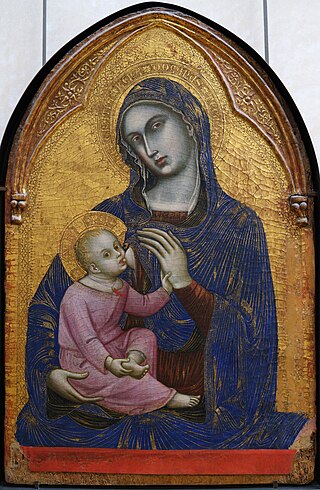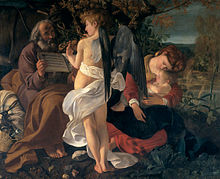
Gerard David was an Early Netherlandish painter and manuscript illuminator known for his brilliant use of color. Only a bare outline of his life survives, although some facts are known. He may have been the Meester gheraet van brugghe who became a master of the Antwerp guild in 1515. He was very successful in his lifetime and probably ran two workshops, in Antwerp and Bruges. Like many painters of his period, his reputation diminished in the 17th century until he was rediscovered in the 19th century.

Quentin Matsys (1466–1530) was a Flemish painter in the Early Netherlandish tradition. He was born in Leuven. There is a tradition alleging that he was trained as an ironsmith before becoming a painter. Matsys was active in Antwerp for over 20 years, creating numerous works with religious roots and satirical tendencies. He is regarded as the founder of the Antwerp school of painting, which became the leading school of painting in Flanders in the 16th century. He introduced new techniques and motifs as well as moralising subjects without completely breaking with tradition.

Annibale Carracci was an Italian painter and instructor, active in Bologna and later in Rome. Along with his brother and cousin, Annibale was one of the progenitors, if not founders of a leading strand of the Baroque style, borrowing from styles from both north and south of their native city, and aspiring for a return to classical monumentality, but adding a more vital dynamism. Painters working under Annibale at the gallery of the Palazzo Farnese would be highly influential in Roman painting for decades.

The Adoration of the Magi or Adoration of the Kings or Visitation of the Wise Men is the name traditionally given to the subject in the Nativity of Jesus in art in which the three Magi, represented as kings, especially in the West, having found Jesus by following a star, lay before him gifts of gold, frankincense, and myrrh, and worship him. It is related in the Bible by Matthew 2:11: "On entering the house, they saw the child with Mary his mother; and they knelt down and paid him homage. Then, opening their treasure chests, they offered him gifts of gold, frankincense, and myrrh. And having been warned in a dream not to return to Herod, they left for their own country by another path".

Martin Schongauer, also known as Martin Schön or Hübsch Martin by his contemporaries, was an Alsatian engraver and painter. He was the most important printmaker north of the Alps before Albrecht Dürer, a younger artist who collected his work. Schongauer is the first German painter to be a significant engraver, although he seems to have had the family background and training in goldsmithing which was usual for early engravers.

In art, a sacra conversazione, meaning "holy conversation", is a genre developed in Italian Renaissance painting, with a depiction of the Virgin and Child amidst a group of saints in a relatively informal grouping, as opposed to the more rigid and hierarchical compositions of earlier periods. Donor portraits may also be included, generally kneeling, often their patron saint is presenting them to the Virgin, and angels are frequently in attendance.

Joachim Patinir, also called Patenier, was a Flemish Renaissance painter of history and landscape subjects. He was Flemish, from the area of modern Wallonia, but worked in Antwerp, then the centre of the art market in the Low Countries. Patinir was a pioneer of landscape as an independent genre and he was the first Flemish painter to regard himself primarily as a landscape painter. He effectively invented the world landscape, a distinct style of panoramic northern Renaissance landscapes which is Patinir's important contribution to Western art. His work marks an important stage in the development of the representation of perspective in landscape painting.

The flight into Egypt is a story recounted in the Gospel of Matthew and in New Testament apocrypha. Soon after the visit by the Magi, an angel appeared to Joseph in a dream telling him to flee to Egypt with Mary and the infant Jesus since King Herod would seek the child to kill him. The episode is frequently shown in art, as the final episode of the Nativity of Jesus in art, and was a common component in cycles of the Life of the Virgin as well as the Life of Christ. Within the narrative tradition, iconic representation of the "Rest on the Flight into Egypt" developed after the 14th century.

The Holy Family consists of the Child Jesus, the Virgin Mary and Saint Joseph. The subject became popular in art from the 1490s on, but veneration of the Holy Family was formally begun in the 17th century by Saint François de Laval, the first bishop of New France, who founded a confraternity.

The Descent from the Cross, or Deposition of Christ, is the scene, as depicted in art, from the Gospels' accounts of Joseph of Arimathea and Nicodemus taking Christ down from the cross after his crucifixion. In Byzantine art the topic became popular in the 9th century, and in the West from the 10th century. The Descent from the Cross is the 13th Station of the Cross, and is also the sixth of the Seven Sorrows of the Blessed Virgin Mary.

Joos van Cleve was a leading painter active in Antwerp from his arrival there around 1511 until his death in 1540 or 1541. Within Dutch and Flemish Renaissance painting, he combines the traditional techniques of Early Netherlandish painting with influences of more contemporary Renaissance painting styles.

The Nativity of Jesus has been a major subject of Christian art since the 4th century.

The Life of the Virgin, showing narrative scenes from the life of Mary, the mother of Jesus, is a common subject for pictorial cycles in Christian art, often complementing, or forming part of, a cycle on the Life of Christ. In both cases the number of scenes shown varies greatly with the space available. Works may be in any medium: frescoed church walls and series of old master prints have many of the fullest cycles, but panel painting, stained glass, illuminated manuscripts, tapestries, stone sculptures and ivory carvings have many examples.

The Mass of Saint Gregory is a subject in Roman Catholic art which first appears in the late Middle Ages and was still found in the Counter-Reformation. Pope Gregory I is shown saying Mass just as a vision of Christ as the Man of Sorrows has appeared on the altar in front of him, in response to the Pope's prayers for a sign to convince a doubter of the doctrine of transubstantiation.

The Nursing Madonna, Virgo Lactans, or Madonna Lactans, is an iconography of the Madonna and Child in which the Virgin Mary is shown breastfeeding the infant Jesus. In Italian it is called the Madonna del Latte. It was a common type in painting until the change in atmosphere after the Council of Trent, in which it was rather discouraged by the church, at least in public contexts, on grounds of propriety.

The world landscape, a translation of the German Weltlandschaft, is a type of composition in Western painting showing an imaginary panoramic landscape seen from an elevated viewpoint that includes mountains and lowlands, water, and buildings. The subject of each painting is usually a Biblical or historical narrative, but the figures comprising this narrative element are dwarfed by their surroundings.

Adoration of the Magi is an oil on panel painting from the early 1520s by the Dutch Renaissance artist Jan Mostaert in the collection of the Rijksmuseum, Amsterdam, where in 2020 it was on display in room 0.1. The panel measures 51 cm × 36.5 cm, and the painted surface a little less at 48.5 cm × 34 cm. It is often called the Mostaert Amsterdam Adoration in art history, to distinguish it from the multitude of other paintings of the Adoration of the Magi.

Landscape with the Flight into Egypt is a 1563 oil on wooden board painting by Pieter Bruegel the Elder, showing the biblical Flight into Egypt of Mary and Joseph with the infant Jesus. It measures 37.1 by 55.6 centimetres and is displayed at the Courtauld Gallery in London.

The Rest on the Flight into Egypt is an oil painting by the Flemish painter Gerard David. It was painted around 1515 and is now housed in the Royal Museum of Fine Arts Antwerp. It can be compared with other works by David which depict the same theme, including paintings located in Madrid, Washington and New York and a Virgin and Child in Rotterdam.

The Flight into Egypt is an oil painting usually attributed to the Venetian Renaissance master Titian. This very early work by Titian was made in about 1508 or 1509. The painting is in the collection of the Hermitage Museum in Saint Petersburg, Russia. A religious landscape painting, its "bold brushwork and exhilarating use of color" have led to it being described as one of Titian's masterpieces, as well as one of his earliest. Though some scholars dispute the attribution of the painting to Titian, it is usually accepted as one of his works from the beginning of his career.


































